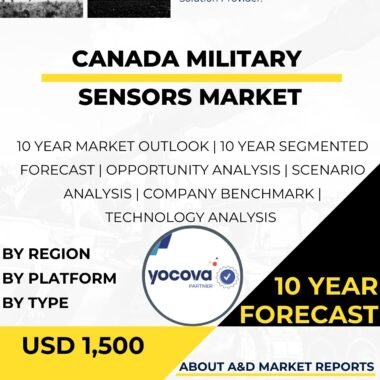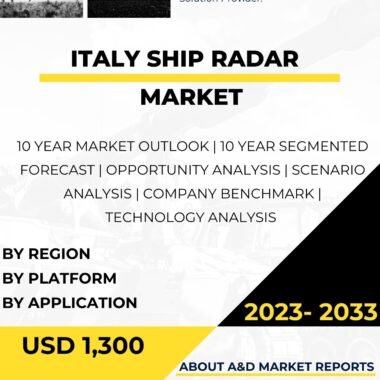Description
Military sensors play a critical role in modern defense operations, providing essential data and information for situational awareness, threat detection, target acquisition, and decision-making. In the Netherlands Defense market, a wide range of military sensors are utilized across various platforms, including ground vehicles, naval vessels, aircraft, unmanned systems, and intelligence, surveillance, and reconnaissance (ISR) assets.
One of the primary applications of military sensors in the Netherlands is in enhancing the Dutch Armed Forces’ intelligence gathering and surveillance capabilities. ISR sensors, such as radars, electro-optical/infrared (EO/IR) cameras, and signals intelligence (SIGINT) systems, are integrated into different platforms to monitor and analyze activities in the air, on the ground, and at sea. These sensors provide real-time data on potential threats, enemy movements, and friendly forces’ locations, allowing commanders to make informed decisions and respond effectively to emerging situations.
Moreover, the Netherlands Military Sensors market addresses the requirements of enhancing situational awareness and self-defense capabilities for various platforms. Sensors integrated into military vehicles, ships, and aircraft offer 360-degree coverage, enabling operators and crew members to detect and track potential threats from all directions. Advanced radars, LIDAR (Light Detection and Ranging) systems, and acoustic sensors enhance platform survivability and responsiveness, enabling the Dutch Armed Forces to operate effectively in contested environments.
Additionally, military sensors play a vital role in targeting and precision strike operations. Targeting sensors, such as laser range finders, target designation systems, and synthetic aperture radars, enable accurate and precise engagement of enemy assets. These sensors are integrated into weapon systems, such as guided munitions and precision-guided missiles, allowing the Dutch Armed Forces to minimize collateral damage and increase operational effectiveness.
Furthermore, the Netherlands’ dedication to innovation is evident in the development and integration of advanced sensor technologies. The Dutch defense industry actively collaborates with technology companies, research institutions, and international partners to explore advancements in sensor capabilities, miniaturization, and data processing. These collaborations drive improvements in sensor performance, sensitivity, and multi-functionality, positioning the Netherlands at the forefront of military sensor technologies.
The Netherlands Military Sensors market also addresses the requirements of unmanned systems and autonomous platforms. Unmanned aerial vehicles (UAVs), unmanned ground vehicles (UGVs), and unmanned surface and underwater vehicles (USVs and UUVs) are equipped with various sensors to conduct reconnaissance, surveillance, and target acquisition missions. These sensors enhance the Dutch Armed Forces’ ability to operate in dangerous or challenging environments without risking human lives.
The export potential of the Netherlands Military Sensors market is also significant. The country’s reputation for high-quality defense systems and its expertise in sensor technology have generated interest from other nations seeking to enhance their own defense capabilities. Exporting advanced military sensors not only supports the Dutch defense industry but also fosters international cooperation and strengthens defense ties with partner countries.
Challenges in the Netherlands Military Sensors market include the need to address evolving threats and technological requirements. As military sensors become more sophisticated and integrated into networked systems, the Dutch defense industry must continually innovate and adapt to keep pace with emerging challenges and opportunities.
Additionally, the Netherlands Military Sensors market must focus on the development of robust training and education programs for sensor operators and maintenance personnel. Effective training is crucial for maximizing the benefits of sensor systems and ensuring their optimal use and maintenance in various operational scenarios.
Furthermore, the Netherlands Military Sensors market must consider the challenge of resource optimization and cost competitiveness. As sensor technologies continue to advance rapidly, ensuring cost-effectiveness and efficient use of resources is essential for maximizing the benefits of military sensors and maintaining the Netherlands’ competitive edge in the global defense market.
In conclusion, while there might not be publicly available specific data on a separate “Netherlands Military Sensors Market,” the broader context of military sensors in the Netherlands is of paramount importance for enhancing defense capabilities and operational effectiveness. Military sensors provide critical data and information for intelligence gathering, surveillance, targeting, and self-defense. The Netherlands’ focus on sensor technology and innovation demonstrates its dedication to providing the highest level of operational readiness and security. Collaborations with technology companies and research institutions, export opportunities, and a dedication to innovation have positioned the Netherlands as a key player in the global Military Sensors market. As the Dutch defense industry continues to invest in research and development, advancements in military sensor technologies will be essential to optimizing capabilities and maintaining the Netherlands’ leadership in the field.




